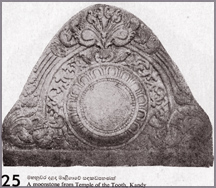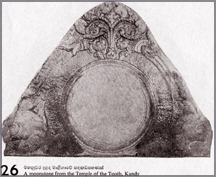|
observer |
|
|
|
|
|
OTHER LINKS |

|

|

|
|
|
|
|
According to archaeological sources, the concept of moonstones was introduced in India, at the time of the Buddha. It is said that the floors of the Pabbarama temple in Shravasthi, built by a wealthy devotee, Visakha, were covered entirely with rich and rare cloths, before she offered it to the Sangha.
Another rich lady wished to offer such clothes, but couldn't find a place to put them. Seeing her disappointment, Ananda Thera asked her to lay them before the flight of steps. Thereafter, almost all the buildings came to have a beautiful first step.
The moonstone is a semi-circular slab of granite or limestone. This is usually the first in a flight of steps. It is richly designed in concentric (with the same centre) semi-circular bands of carvings of flowers, creepers, birds and animals.
|
|
Moonstones of the Anuradhapura era are not intricately carved, but after the 13th century, this started to change rapidly and the moonstones started to be filled with heavy decorations. These decorations are done according to geometry. The ancient ones have designs inside a few parallel half circles. The most outstanding moonstone is the one at the Anuradhapura Dalada Maligawa.
The moonstone is called the Sandakadapahana or Irahandagala in Sinhala. This is related to the Sun, because in earlier times, many cultures of the world venerated the Sun, as the giver of life, fertility and growth.
In the same way, lotus flowers in the moonstone emphasise the importance of the sun to life itself and it is symbolised by the flower, which blooms with the rising sun and stays open only so long as the sun shines.
|
|
In ancient times, people believed that the moonstone will bring them prosperity if they are touched with it. So, every religious place and other important places had a moonstone at the entrance.
Some of the important features in the moonstone are the arc of flower petals (Palapethi) motif, which depicts the fire of worldly existence; arc of four beasts (elephant, lion, horse and bull) which depicts the four mortal perils - birth, disease, decay and death; the arc of undulating (wavy) scrolls of leaves and flowers forming the liyavela motif, depicting desire or craving; the arc of swans, depicting the thoughtful ones who have left their abodes; the arc containing a second liyavela motif, which depicts the heavenly worlds; the arc of lotus petals turned outwards and the arc of petals turned inwards and joining in the centre, forming half a lotus, which depicts Nirvana.
The first moonstones were rectangular in shape, but later became half a circle; sometimes, it became closer to a circle as well. During the Polonnaruwa era, the bull was removed from the moonstone, because of the Hindu influence. Some of the moonstones have stone inscriptions as well, e.g. at Mihintalawa.
The letters in these stone inscriptions belong to the era after the sixth century. It's suspected that these inscriptions have been done sometime after they have been in use as steps.
Moonstone from the Temple of the Tooth, Anuradhapura
The sculpture found on this moonstone is in conformity(similar)with that of others of the period, but the geese in the band beyond the lotus do not carry anything in their beaks. This is a deviation from the generality of the Anuradhapura moonstones.
|
|
At the beginning and at the end of this line of geese, are lotus buds and flowers. As a work of art, this moonstone is superb. The centre of the semi-circle is occupied by a large lotus with its open petals as well as those in the bud distinctly carved out.
Moonstone from the Temple of the Tooth, Kandy
Moonstones shaped like part of an oval have come after those which were shaped like the major segment of a circle. The central lotus here is complete. Its petals are worked out, but the centre, apart from the beaded line at its rim, is plain. At the upper end of the lotus is a vase holding leaves and buds, all done in Vaka - carving.
These cover the circumference completely, but have between them and the otus a space which is filled in by a rambling creeper design. This creeper is rather stiff and unnatural.














